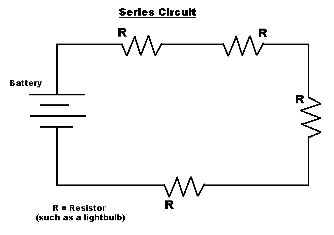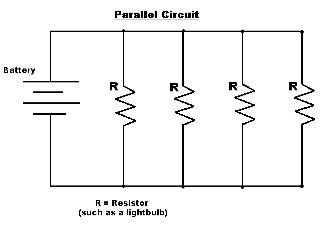Energy in a Circuit: Difference between revisions
No edit summary |
No edit summary |
||
| Line 54: | Line 54: | ||
[[File:Parallel Circuit.jpeg]] | [[File:Parallel Circuit.jpeg]] | ||
==Ohm's Law== | |||
==Connectedness== | ==Connectedness== | ||
| Line 78: | Line 81: | ||
==References== | ==References== | ||
#http://hyperphysics.phy-astr.gsu.edu/hbase/electric/resis.html#c1 | |||
#http://hyperphysics.phy-astr.gsu.edu/hbase/electric/ohmlaw.html | |||
#http://farside.ph.utexas.edu/teaching/302l/lectures/node61.html | |||
#http://www.physicsclassroom.com/class/circuits/Lesson-4/Parallel-Circuits | |||
#http://science.howstuffworks.com/environmental/energy/circuit3.htm | |||
[[Category:Which Category did you place this in?]] | [[Category:Which Category did you place this in?]] | ||
Revision as of 18:27, 5 December 2015
Claimed by Neevedita Goswami
Preface
Energy in a circuit originates from the battery, and once the circuit is closed, it flows through the wires.
Definitions
Power
Power is measured in watts, and in a circuit, it is the rate at which energy is converted from electrical energy to a different type of energy.
[math]\displaystyle{ \mathbf{P} = }[/math] Power
[math]\displaystyle{ \mathbf{P} = \mathbf{I} * \mathbf{V} }[/math]
Resistance
Resistance is measured in ohms. It slows the flow of the charge and is the ratio of the voltage applied to the electrical current flowing through it. Examples include lights, fans, and any appliances within the circuit. The longer the wire, the greater its resistance. Total resistance is calculated differently depending on the type of circuit: series or parallel.
[math]\displaystyle{ \mathbf{R} = }[/math] Resistance
[math]\displaystyle{ \mathbf{R} = \frac {\mathbf{V}} {\mathbf{I}} }[/math]
Voltage
Voltage, or electric potential, is measured in volts. It is the electrical potential energy per unit charge and, in reference to class problems, determines the brightness of a light bulb along with power. Voltage is calculated differently depending on the type of circuit: series or parallel.
[math]\displaystyle{ \mathbf{V} = }[/math] Voltage
[math]\displaystyle{ \mathbf{V} = \mathbf{I} * \mathbf{R} }[/math]
Current
Current is measured in amperes. It is the energy that flows through the circuit and has different rules to its calculations depending on the type of circuit.
[math]\displaystyle{ \mathbf{I} = }[/math] Current
[math]\displaystyle{ \mathbf{I} = \frac {\mathbf{V}} {\mathbf{R}} }[/math]
Series Circuits
A series circuit is when all the resistors within the circuit are on one path. There is one path leading from the power source, through the resistors, and back to the source.
Total resistance in a series circuit is calculated by adding the resistance of all the resistors in series together.
[math]\displaystyle{ \mathbf{R}_{total} = \mathbf{R}_{1} + \mathbf{R}_{2} + \mathbf{R}_{3} + ... }[/math]
The current is constant throughout the paths in series.
Parallel Circuits
A parallel circuit is when there is more than one path leading from the power source for the current to flow through. Total resistance in a parallel circuit is calculated by adding the inverse of each resistor in the parallel wires and then taking the inverse of the total.
[math]\displaystyle{ \frac {1} {\mathbf{R}_{total}} = \frac {1} {\mathbf{R}_{1}} + \frac {1} {\mathbf{R}_{2}} + \frac {1} {\mathbf{R}_{3}} + ... }[/math]
When the paths of a parallel circuit branch off from the original path, the currents of those paths will always add up to the current of the original path.
Ohm's Law
Connectedness
- In middle school, I made a house with working appliances. It was such an enthralling experience, and I enjoyed making the circuits and figuring out which ones would work best by calculating battery wattage and application resistance.
- I am a computer science major, but if I want to do into the devices thread, knowing how these circuits work would be beneficial. With that knowledge in addition to computer programming knowledge, I would be able to thoroughly understand the top-down making of the device.
- Circuits are used all around us. From within our appliances to the outlets we plug them into, circuits are the basis of most technology we use today. You could apply circuits to almost any industry.
History
Put this idea in historical context. Give the reader the Who, What, When, Where, and Why.
See also
Are there related topics or categories in this wiki resource for the curious reader to explore? How does this topic fit into that context?
Further reading
Books, Articles or other print media on this topic
External links
References
- http://hyperphysics.phy-astr.gsu.edu/hbase/electric/resis.html#c1
- http://hyperphysics.phy-astr.gsu.edu/hbase/electric/ohmlaw.html
- http://farside.ph.utexas.edu/teaching/302l/lectures/node61.html
- http://www.physicsclassroom.com/class/circuits/Lesson-4/Parallel-Circuits
- http://science.howstuffworks.com/environmental/energy/circuit3.htm

